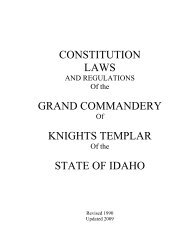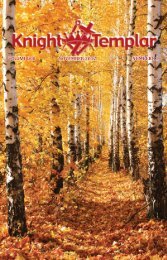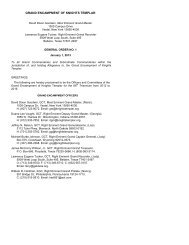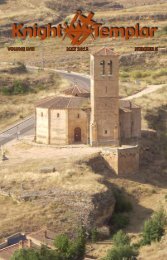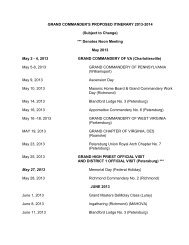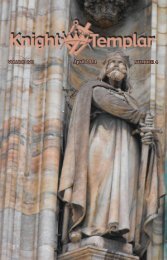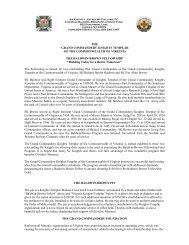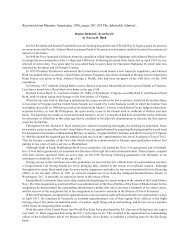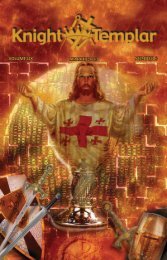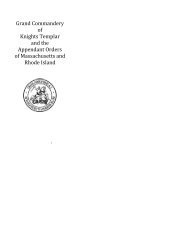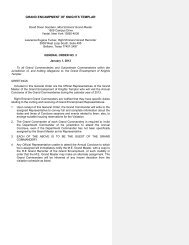january - Grand Encampment, Knights Templar
january - Grand Encampment, Knights Templar
january - Grand Encampment, Knights Templar
Create successful ePaper yourself
Turn your PDF publications into a flip-book with our unique Google optimized e-Paper software.
carry on its own unique culture.As the Wigan <strong>Grand</strong> Lodge descendedinto solitary isolation, “regular” Freemasonryunder the United <strong>Grand</strong> Lodgeof England flourished in Wigan. The Provincial<strong>Grand</strong> Lodge of West Lancashiremet there in October 1886, and in Novemberof the same year, the WiganFreemasons under the United <strong>Grand</strong>Lodge celebrated the centenary of theLodge of Antiquity No. 178. More visitsby prominent figures within the United<strong>Grand</strong> Lodge followed. In October 1889,the Freemasons accompanied the Mayorto church, and a sermon was given bythe <strong>Grand</strong> Chaplain of England, the ReverendT. Barton Spencer. Perhaps thesevery public displays by the ever morepowerful and confident United <strong>Grand</strong>Lodge sent a message to the dwindlingWigan <strong>Grand</strong> Lodge.Indeed, “regular” Freemasonry inWigan, like in other industrial towns atthe time, attracted the local aristocracy.One such local aristocrat was JamesLudovic Lindsay FRS (Fellow of the RoyalSociety), who resided at Haigh Hall, anelegant neo-classical manor house onthe outskirts of Wigan. 37 Lindsay was tobecome the 26 th Earl of Crawford and9 th Earl of Balcarres, and he founded theLindsay Lodge No. 1335 in 1870, LordLindsay serving as a Conservative MP(Member of Parliment) for Wigan from1874-1880. Lindsay became a central figurefor Freemasonry in Wigan, becominginvolved in the development of localeducation and charity. His family hadbeen concerned in the opening of thelocal mining and mechanical school, andLord Lindsay had been involved in thebuilding of local school houses. 38 Lindsaybecame a celebrated astronomer, andtogether with his father, they had builtup one of the most impressive librariesin Britain, the “Bibliotheca Lindesiana.”In 1910, Haigh Hall played host to a visitingcontingent of Manchester Masons,again confirming the power and statusof “regular” Freemasonry against the increasinglysecluded Wigan <strong>Grand</strong> Lodge.Miller was to witness the end of the<strong>Grand</strong> Lodge of Wigan, its last survivinglodge being isolated and alone, and as arelic of the “Antients” of the eighteenthcentury, it was not recognized by otherlocal Masonic lodges. Despite the rulingpassed in the early days of the <strong>Grand</strong>Lodge that it was forbidden to discussthe United <strong>Grand</strong> Lodge, Miller mentionsthat “heated arguments” on rejoininghad been going on for two or threeyears leading up to 1913. The matterwas brought to a head, as Miller puts it,in 1912, when an unnamed newly raisedbrother received an invitation to visit aMasonic lodge under the United <strong>Grand</strong>Lodge of England. On presenting himselfto the lodge and showing his certificate,he was refused admission, whichled him to write a rather abusive letter,calling the lodge a bogus institution andstating that he was the victim of a fraud.This incident seemed to confirm that theSincerity Lodge, the last surviving lodgeunder the <strong>Grand</strong> Lodge of Wigan, had ableak future, and if it was to survive, itneeded to adapt.A meeting between both <strong>Grand</strong> Lodgeswas sought, and the Sincerity Lodge wasvisited by Worshipful Brother J. D. Murreyfrom Provincial <strong>Grand</strong> Lodge, who wassatisfied with what he witnessed of theworking of the lodge. Miller recites thatdevelopments moved quickly and that thelodge could keep the name “Sincerity” butwould have to be renumbered. Ironically,the issue over the renumbering of lodges14 <strong>january</strong> 2013




